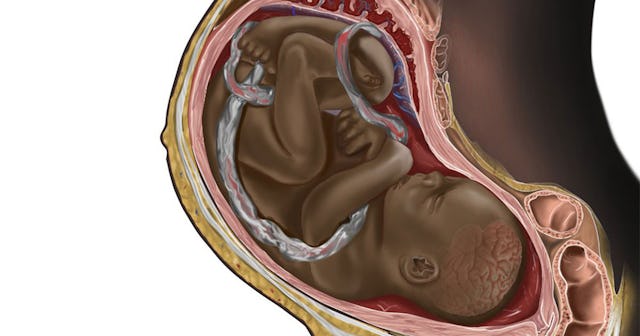We Shouldn’t Be THIS Surprised At A Representation Of A Black Fetus

Last weekend, an image created by Nigerian medical student and Illustrator Chidiebere Ibe caught the attention of pretty much everyone on social media. The illustration depicts a Black pregnant woman and shows a Black fetus inside her belly. In case you’re wondering why this is even news, it’s because many up until that point had never seen an image like Ibe’s.
As a mom of three, this was only my second time seeing a fetus with a different skin tone. The first was just last year, in 2020, while pregnant with my third baby. The app pregnancy+ allows you to select from a range of skin tones and depicts fetuses based on your selection. But I’m willing to say that judging by the reactions all over social media, many people haven’t even seen that.
New York Times bestselling author Luvvie Ajayi Jones posted the image to her Facebook, which had been shared with the caption “I’ve literally never seen a Black fetus illustrated, ever.”
The reaction to the image just continues to prove what people of color already know: People with darker skin tones are underrepresented in many aspects of life, and the medical field is included.
Ibe, who is studying to become a pediatric neurosurgeon, hopes to bridge that gap with his drawings. “The under representation of Black skin medical illustration in the public health sector has brought a bridge in doctor-patient communication” he wrote on Instagram. “My goal is to create medical illustration of such, and this can’t be done with a fair knowledge of medicine.” To date, Ibe’s GoFundMe which contributes to his medical training has surpassed his goal.
“I started medical illustrations to promote the use of Black skin illustrations in our medical textbooks to depict a typical African person. Textbooks are essentially invincible to medical training. They walk medical trainees through conditions they will encounter during their practice. Yet, most medical illustrations are on the Caucasian skin. This lack of diversity has important implications for medical trainees and their future patients because many conditions and signs look different based on the patient’s skin colour and therefore the Black skin should be equally represented,” Ibe said on his GoFundMe page.
Racial disparities in the medical world are not only extremely frustrating, but they contribute to a large amount of the medical myths concerning Black people and people with darker skin tones.
False information such as Black people having thicker skin and not needing to wear sunscreen still circulates within those communities. With little to no images depicting people of color in medical books, this lack of representation can lead to misdiagnosed skin conditions, poor (or no) pain management, and even delayed diagnoses.
According to the CDC, Black women are three times more likely to die from a pregnancy-related cause than white women. Multiple factors contribute to these disparities, such as variation in quality healthcare, underlying chronic conditions, structural racism, and implicit bias. The complete awe people were in from seeing Ibe’s image sends a painful reminder to BIPOC that we are invisible even before birth.
Black parents should be able to look up any skin condition online and not have to scroll to page 5 or 6 before seeing their skin tones represented. People with darker skin tones don’t deserve to still be “otherized” this late in the game. Hopefully Ibe’s images are a wake up call to the medical community. It’s almost 2022 — time to get it together.